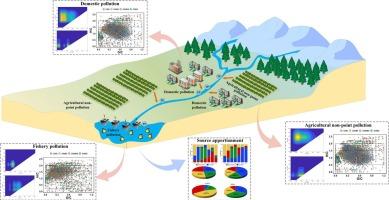典型热带岛屿流域污染特征识别及其对污染源分配的意义——以三亚为例
IF 8
1区 环境科学与生态学
Q1 ENVIRONMENTAL SCIENCES
引用次数: 0
摘要
由于土地利用模式的异质性和季节性的人为活动,热带沿海流域面临着复杂的污染挑战。以三亚市中心渔港为研究对象,建立了多维污染指纹图谱框架。我们整合了四个分析层次:(1)对代表污染源的水质参数进行多元统计筛选;(2)利用三维激发-发射矩阵荧光光谱结合平行因子分析(EEM-PARAFAC)对溶解有机物(DOM)进行季节性分析;(3)基于多源变量的受体模型进行污染分摊;(4)利用傅里叶变换离子回旋共振质谱(FT-ICR MS)在分子水平上验证污染源。对比模型表明,PCA-APCS-MLR在可追溯精度上优于PMF (R2 > 0.82比>0.65),特别是在解决渔业和生活污水重叠贡献方面。主要研究结果表明,由于渔业活动,污染源贡献存在很强的时空异质性,EEM-PARAFAC和FT-ICR MS在定性污染源识别方面具有互补能力。基于对水质理化参数、荧光光谱和质谱的整合,有效提高了复杂、重叠污染源的溯源和解析精度。这种综合方法突出了多参数集成(物理化学-光学-质谱)对沿海受体建模的协同价值,为热带河口污染管理提供了可转移的模板。本文章由计算机程序翻译,如有差异,请以英文原文为准。

Identification of pollution properties in typical tropical island watershed and their significant for source apportionment: A case study of Sanya, China
Tropical coastal watersheds face complex pollution challenges due to heterogeneous land-use patterns and seasonal anthropogenic activities. This study developed a multi-dimensional pollution fingerprinting framework to resolve source contributions in Central Fishing Port, Sanya, China. We integrated four analytical tiers: (1) multivariate statistical screening of water quality parameters represented pollution sources, (2) seasonal analysis of dissolved organic matter (DOM) with three-dimensional excitation-emission matrix fluorescence spectroscopy combined with parallel factor analysis (EEM-PARAFAC), (3) pollution apportionment using receptor model based on multi-source variables, and (4) validation of pollution sources at molecular-level with Fourier transform ion cyclotron resonance mass spectrometry (FT-ICR MS). Comparative modeling demonstrated that PCA-APCS-MLR outperformed PMF in traceability accuracy (R2 > 0.82 vs. >0.65), particularly in resolving overlapping fishery and domestic sewage contributions. Key findings demonstrated that there was strong spatiotemporal heterogeneity in pollution source contributions due to the fishing activities, and complementary capabilities of EEM-PARAFAC and FT-ICR MS for qualitative source identification. Based on the integration of physicochemical parameters of water quality, fluorescence spectra and mass spectrometry, the traceability and apportionment accuracy of complex and overlapping pollution sources were effectively improved. This integrated approach highlighted the synergistic value of multi-parameter integration (physicochemical-optical-mass spectrometric) for coastal receptor modeling, providing a transferable template for tropical estuary pollution management.
求助全文
通过发布文献求助,成功后即可免费获取论文全文。
去求助
来源期刊

Science of the Total Environment
环境科学-环境科学
CiteScore
17.60
自引率
10.20%
发文量
8726
审稿时长
2.4 months
期刊介绍:
The Science of the Total Environment is an international journal dedicated to scientific research on the environment and its interaction with humanity. It covers a wide range of disciplines and seeks to publish innovative, hypothesis-driven, and impactful research that explores the entire environment, including the atmosphere, lithosphere, hydrosphere, biosphere, and anthroposphere.
The journal's updated Aims & Scope emphasizes the importance of interdisciplinary environmental research with broad impact. Priority is given to studies that advance fundamental understanding and explore the interconnectedness of multiple environmental spheres. Field studies are preferred, while laboratory experiments must demonstrate significant methodological advancements or mechanistic insights with direct relevance to the environment.
 求助内容:
求助内容: 应助结果提醒方式:
应助结果提醒方式:


